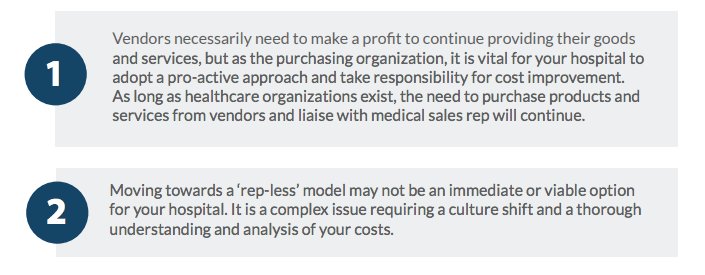The Hospital and The Sales Rep
This year’s predicted 5.3% increase in healthcare costs is part of an upward trend expected to propel spending up to $5.7 trillion by 2026¹ . The rising cost of medical goods and services contributes significantly towards that trend. While increased spending would normally equate to better quality for the consumer, in the arena of healthcare this is not necessarily the case.
The push towards a value-based model is driving healthcare organizations to provide the best possible patient care at the lowest possible price. The most successful combine these factors as they seek to serve their patients and communities. But in striving to do so, they encounter a conflict of interest.
While a doctor’s priority is patient care, the goal of the vendors of vital medical goods and services is to realize a profit. To achieve their goal they employ sales reps to sell their products at the highest possible price. The higher the price tag, the more commission a sales rep will earn and however ethical their intentions, their motivation is often the need to meet or exceed their on-target earnings in this lucrative market.
The sales rep in your Operating Room
Medrep’s 2018 Medical Sales Salary Report highlights the reliance on commission-based earnings behind this conflict of interest². Taking just one example, sales reps selling surgical devices doubled their base salary with commission last year.
To quote the report,
“sales representatives do whatever it takes to make the sale”
For one third that means regularly working in a hospital’s O.R. The argument for the presence of sales reps in the O.R. claims they offer a tangible benefit to surgeons and medical professionals. Their in-depth knowledge of the devices they sell, it’s suggested, can increase efficiencies in the O.R.
A 2016 research paper examining the relationship between surgeons and medical device
representatives challenges this assumption by highlighting potentially ethical issues,
including:³
- The extent of the reliance of surgeons on sales reps and their employers for
education and surgical assistance in the O.R. - Practical concerns related to levels of competence among O.R. employees.
- The need for unbiased assessments of surgically implanted devices to foster
evidence-based practice – a requirement which ‘cannot be overstated’. Medical
sales reps, it suggests, are unable to provide this as they are highly trained in and
biased towards products from a single vendor.
A further article from The Washington Post describes sales reps as a constant presence in
the O.R., primarily to answer the questions of the surgeons related to the operation of
their devices. The article notes that, while this may be beneficial, it is often without the
knowledge or informed consent of the patient – and sometimes to the ultimate detriment
of their care⁴.
The sales rep also has considerable influence over the surgeon’s choice of device in this
scenario but that recommendation is not necessarily based on what is best for the patient.
Finding a solution
There are two areas to consider:

Implementing the following strategies can begin to address those issues:
1. Raising cost awareness in the Operating Room
When products are clearly labeled with pricing in the O.R., individuals become more
cost conscious⁵. From my observations, a responsible caregiver always puts the patient
first and minimizes the use of higher priced items when a less expensive option will
produce the same – if not better – results.
For example, in the fast-paced world of perioperative nursing, a PACU nurse/aide may
need to retrieve a Foley catheter kit to use for a patient and has a choice of two. Only one
may be equipped with a temperature sensor but in the moment, it can be difficult to
differentiate. The nurse/aide selects the catheter with the temperature sensor,
concluding that it is better to have that available, even if they do not need it. When the
kit is required again, they develop a habit of using the more expensive catheter.
Over the course of a year, this type of repeated action can lead to thousands of dollars of unnecessary waste, which could be diverted to improving patient care. Click To Tweet
It is a scenario which plays out in hospitals across the country in many different contexts.
2. Seeking price transparency from vendors
In my experience, an overarching attitude of secrecy often permeates negotiations with sales reps who attempt to conceal product costs or prevent hospitals from discovering that other organizations have paid a much lower price for the same product.
The Commonwealth Fund, whose motto is to provide ‘affordable, quality healthcare for everyone’, states that price transparency is one way ‘to encourage consumers to choose low-cost, high-quality providers and to promote competition based on the value of care.’⁶ In the increasingly expensive world of healthcare – where people’s lives and well-being are at stake – an informed decision is critical. This includes knowing the cost of care for a patient.
Again, we see a conflict of interest. Some hospitals have attempted to address this issue through legislation that requires vendors to disclose prices, while some vendors have attempted to address it through litigation and by creating contracts that do not allow hospitals to disclose pricing. In the light of concerns over rising prices and the ethical issues discussed in this article, the onus is on healthcare organizations to negotiate the best prices for the products and services they need to care for their patients. By knowing what comparable items cost, healthcare organizations are able to make informed decisions regarding which products are best-suited for a patient’s care and which may result in the best value.
3. Moving towards the ‘rep-less’ model
For healthcare organizations moving towards the rep-less model, the conclusions from the 2016 report included the following:
- A recommendation that hospitals employ salaried individuals trained in a variety of medical devices to assess and select the most suitable for their patients. In this model, financial incentives would not apply.
- Implementing a program which enables surgical assistants to replace the role of the sales rep in the OR. These employees would undergo full technical training on medical devices of a similar standard to the reps, reducing the reliance on their continued presence.
- Purchasing implants directly from the manufacturer or at a substantial discount. In a world of rising healthcare costs, this may become the ultimate goal for every healthcare organization.
At VIE Healthcare, we emphasize the need for our clients to have a customized cost strategy. This cost strategy is unique to your hospital or health system and becomes the framework for transforming your organization’s costs and achieving unparalleled cost savings year over year.
1 https://www.reuters.com/article/us-usa-healthcare-spending/u-s-healthcare-spending-to-climb-5-3-percent-in-2018-agency- idUSKCN1FY2ZD
2 https://www.medreps.com/medical-sales-careers/medical-sales-salary-report
3 https://www.ncbi.nlm.nih.gov/pmc/articles/PMC4972437/
4 http://www.ihi.org/communities/blogs/what-s-keeping-quality-leaders-up-at-night
5 https://www.washingtonpost.com/national/health-science/why-is-that-salesperson-in-the-operating-room-for-your-knee- replacement/2016/11/14/ab8172fa-78e6-11e6-beac-57a4a412e93a_story.html
6 https://www.commonwealthfund.org/publications/newsletter/health-care-price-transparency-can-it-promote-high-value-care



